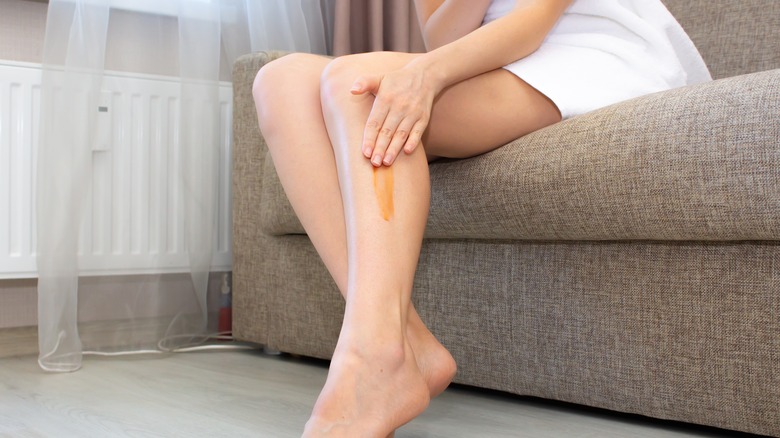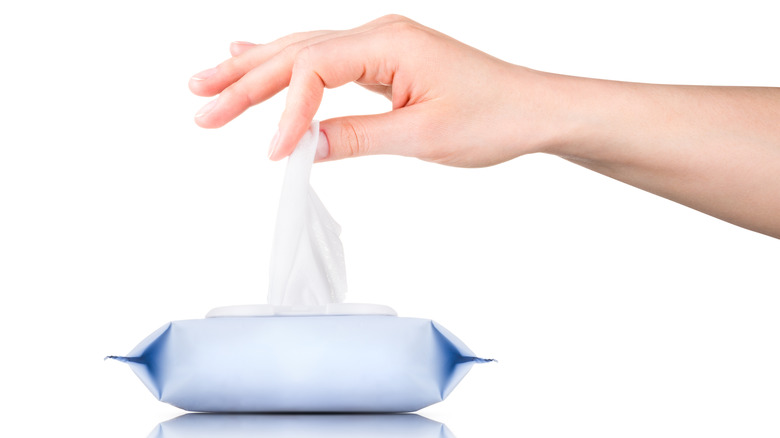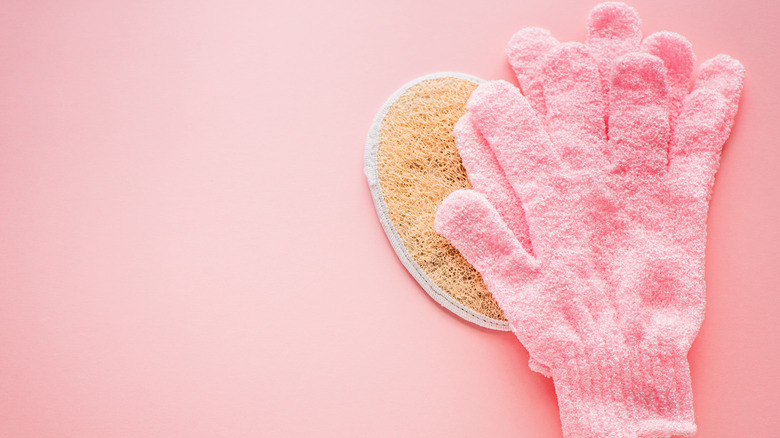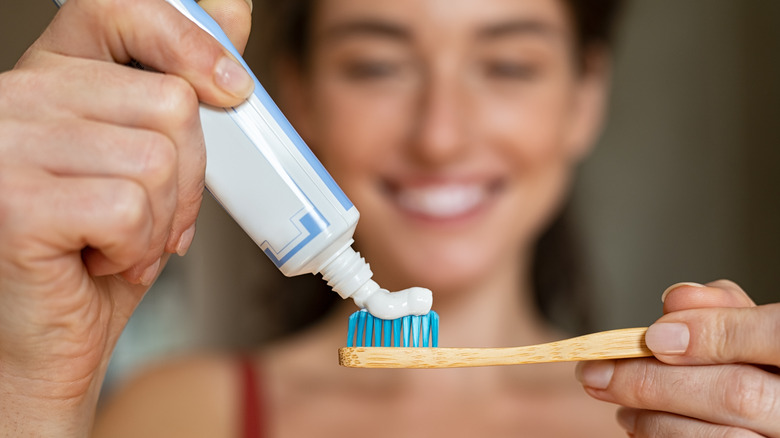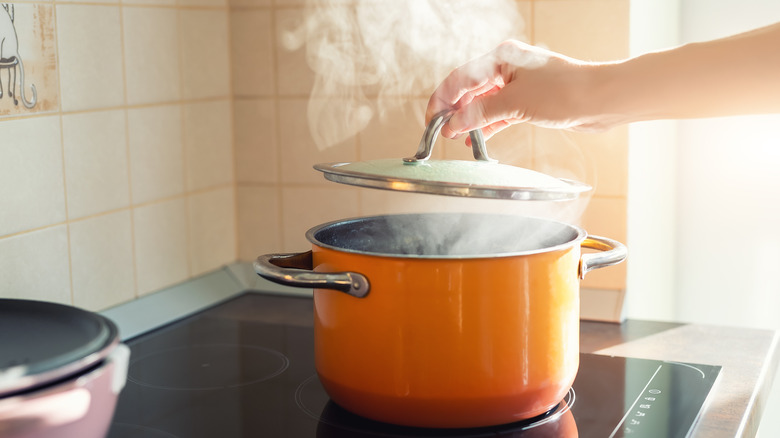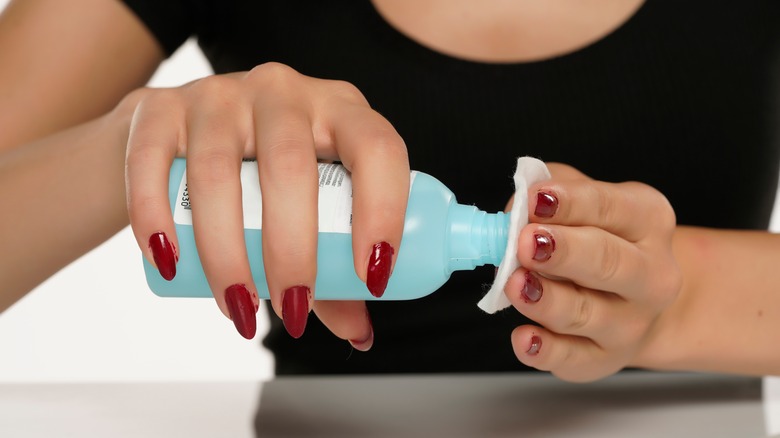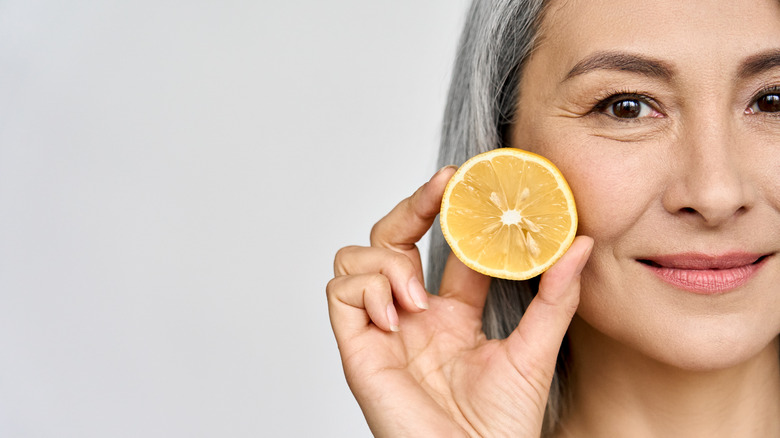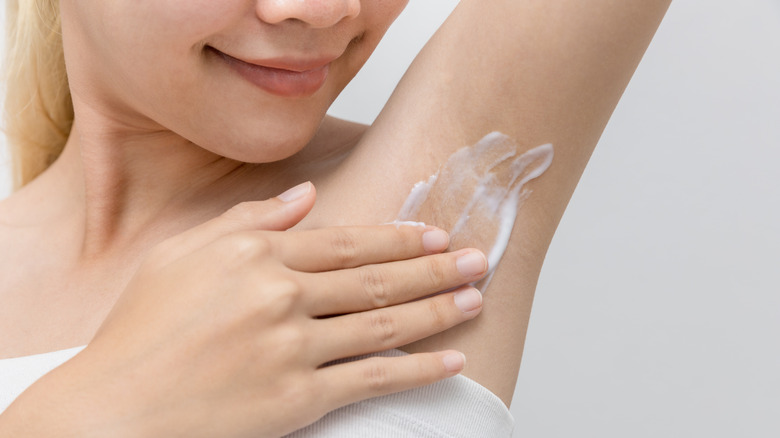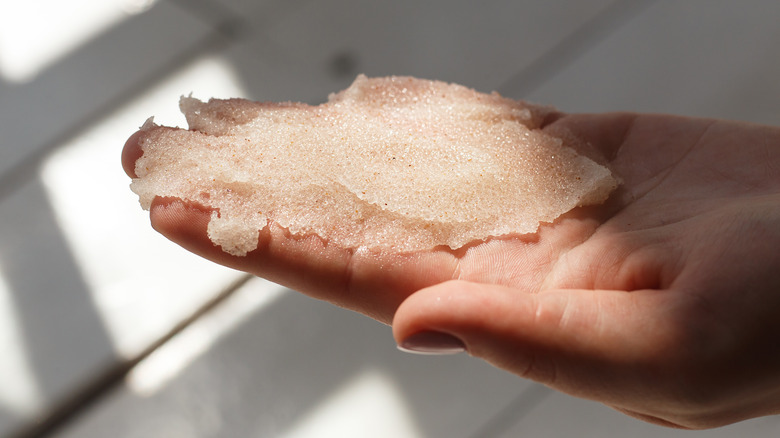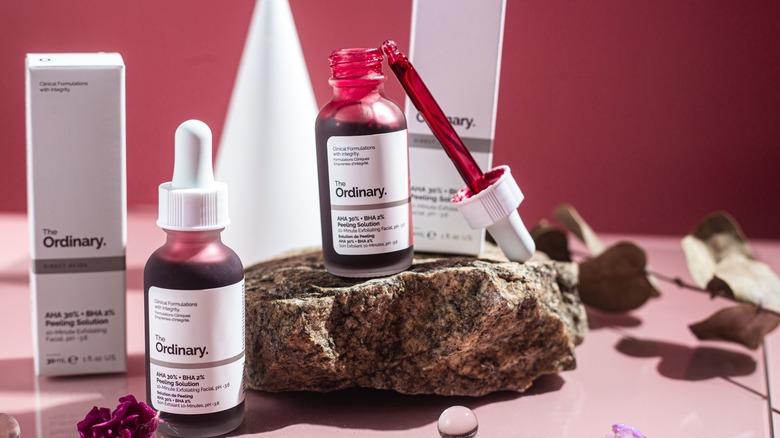10 Easy Ways To Remove Self-Tanner From Your Hands
As more and more people are aware of the dangers of exposure to UV radiation, whether through sunlight or sunbeds, self-tanner has become more and more popular. According to the National Cancer Institute, "exposure to UV radiation causes early aging of the skin and damage that can lead to skin cancer." Using self-tanner means that you can still have that summer tan without actually having to risk your health. However, the art of perfecting self-tanning isn't one that is easily mastered. From picking the right product and the right shade to learning how to apply it without having streaks — self-tanning usually comes with a high learning curve. Luckily, once you find the product that works for you and you master its application, nothing can stand between you and that perfect summer tan. Except for maybe your hands which tend to absorb self-tanner more than anybody wants them to.
Back in 2018, model Ashley Graham used social media to share her self-tanner removing hack which included spraying your skin with Windex (via People). Soon after, experts voiced their opinion on the household hack, with Dr. Shereene Idriss stating that "Windex might be your go-to staple for household grime, but when it comes to skincare it should be a no-go" (via Teen Vogue). What's more, because Windex contains "harsh ingredients such as ethanolamine and ammonium hydroxide that may cause severe skin irritations and eventually lead to infections," Idriss explains that it isn't a household hack you should try.
Luckily, there are plenty of other home remedies that will help fix your streaky and over-tanned hands very quickly. Whether you have lemons, toothpaste, or hair-removal cream, the following are our favorite home remedies for getting rid of patchy hands — and safely.
Baking soda paste is everyone's go-to
Baking soda is a household staple, which is why it's the most commonly used at-home self-tanner removal method. All you need to do is turn it into a paste — you can use water or oil for that — and then gently apply it to the area where you want to remove the self-tanner. Let it sit for a minute, and then start scrubbing it away.
According to Beauty Daily, 2 tablespoons of baking soda and a little bit of coconut oil will do the trick. The reason why baking soda works flawlessly is that it removes that outermost layer of skin that was dyed by the self-tanner (via Medical News Today). And while there are plenty of household items that could be used as a scrub to remove that skin, baking soda is very effective as it not only gets the job done — but also doesn't irritate the skin, which is always a plus.
Apart from removing self-tanner, per WebMD, baking soda also soothes the skin as it can help with irritation, pain, itching, and redness. In fact, adding ½ cup of baking soda to your bath will help make your skin ultra-soft. Because of this, baking soda is also a great step to incorporate into your pre-tanning routine — it will help exfoliate and make your skin soft which will result in a longer-lasting tan!
Baby wipes are great for fixing mistakes on the go
We've all been there: you thought you did a great job with self-tanner only to realize your hands are stained once you've already left home. You generally have two choices: going back home and spending time fixing your stains which means that you will be late or owning the streaks while trying to keep your hands unnoticeable. Let's be real: neither option is ideal.
A great thing to have in your bag is baby wipes, as they can help lift some of that self-tanner from your hands. While they aren't as efficient as acidic products or scrubs, they smell much more pleasant and they are mess-free. Getting a travel-sized pack of baby wipes is a great thing to have in your bag if you wear self-tanner on a regular basis. According to Pure Wow, it is best to use baby wipes as soon as you notice that the tan is uneven. The earlier you use them, the easier it will be to fix the mistake.
The way that baby wipes work is very similar to baking soda, just a lot more gentle and much easier to use on the go. They help remove that outermost layer of skin, so make sure to only use them in spots where your skin is streaky and stained. While they may not remove the self-tanner completely, they will definitely make the mistake much less noticeable.
Exfoliating gloves and oil are the best options for big areas
An easy way to tackle big areas covered in self-tanner is to get a pair of exfoliating gloves — you can find them online and in drugstores — and use them together with baby, olive, or coconut oil. According to MasterClass, the best way to do it is to rub the oil into the skin and let it sit for a few minutes. After that, gently exfoliate with the gloves and watch the self-tanner come off. When doing this to your hands, you'll have to scrub one hand at a time.
Apart from fixing mistakes, a pair of exfoliating gloves is also a game changer in your pre-tanning routine. According to Dr. Rekha Tailor of Health & Aesthetics, exfoliating gloves should be a staple in everyone's at-home skincare routine. "Exfoliating gloves are an at-home alternative to a scrub-down in a spa and can help to create softer skin. The glands in your skin produce oil that maintains it. But too much of that oil, plus dead skin cells, can build up and cause blocked pores which can result in breakouts," Dr. Tailor told Women's Health.
According to Sunless Rae, it's best to exfoliate 24 hours prior to applying your self-tanner, and we don't mean only knees and elbows but rather everywhere you plan to put the self-tanner on, including your hands. Using exfoliating gloves with your favorite body wash is an easy way to incorporate regular exfoliation into your weekly skincare routine. Trust us: your skin will feel soft even without layers of moisturizer, even though you should still apply some. However, make sure that once you apply self-tanner, you avoid exfoliating until you notice that your tan is patchy and you actually want to take it off.
Whitening toothpaste works great for small areas
Because whitening toothpaste tends to have sodium bicarbonate in it, it is also great at fixing little self-tanner mistakes. According to Coco & Eve, you should apply toothpaste directly to the area you want to lighten and then let it sit for approximately 10 minutes. After that, rinse it off, and the self-tanner should look a lot more even.
According to the Daily Mail, if you have a case of orange hands, rub a small amount of whitening toothpaste around the palms and especially focus on the areas around your nails, which tend to be drier hence they take on a lot more self-tanner than the rest of your hands. This will help you get rid of those mistakes quickly. Thanks to its consistency and cleaning ability, whitening toothpaste is an easy solution for self-tanner mistakes.
However, be cautious as toothpaste can irritate sensitive skin, so if you notice any redness or itching, remove it immediately and apply a soothing cream on the area. According to board-certified dermatologist Dr. Tsippora Shainhouse, toothpaste can mess with your skin's pH levels. "Toothpaste has a basic pH [level]... and can irritate healthy skin, which has a naturally acidic pH," Dr. Shainhouse told Healthline.
Steam your hands (over a pot with hot water)
Anyone who self-tans frequently knows that sweating a lot or going to a pool/sauna will result in removing some of that tan. Because of this, removing unwanted hand stains with steam is an easy way to deal with self-tanner mistakes (via Marie Claire).
If you have a facial steamer, use that, and if not, heat a pot of water and then place your hands above it allowing that steam to break down the self-tanner on your hands. Of course, be extra careful with the heat, you don't want to touch the water or burn your hands so don't let them come too close to the pot. Steam your hands for three to five minutes and then check if some of the self-tanner can be rubbed off.
Apart from hands, steam is a great method to help remove unwanted self-tanner mistakes from your face as it is gentle enough on the skin, and it doesn't require heavy exfoliation (via Be Beautiful), which can irritate those with sensitive skin or acne. All you have to do after the steaming — regardless if it's your hands, face, or whole body — is gently rub your skin with a wet towel in circular motions. Disclaimer: don't be alarmed by the amount of tan/dead skin you might end up seeing on the towel.
Acetone nail polish remover is great for stubborn spots
If your self-tanner mistakes are stubborn and nothing else works, give acetone nail polish remover a shot. Suvara tanning solution founder Anna Stankiewicz revealed to Fashionista that she uses nail polish remover to fix any small areas. "Use nail polish remover to get rid of small areas of self-tanner hyperpigmentation or to fade certain areas," Stankiewicz explained. "Obviously nail polish remover can be a bit harsh, so test an area first."
Acetone nail polish remover is perfect for removing those tiny dark spots around your nails and knuckles (via Jergens). While Stankiewicz does use acetone regularly, it is crucial to only use it on small areas and rinse them immediately after. Never use acetone nail polish remover on an entire body part; instead, put it on a Q-tip or small cotton pad and only apply to the most noticeable and streakiest spots. While it is safe to use this hack on your hands, never use acetone nail polish remover on your face or any delicate and sensitive areas on your body. Because acetone will remove your tan, make sure to never get your nails done after a fake tan session (via She Said). Either get them done before or wait until the tan starts looking patchy.
Something acidic like vinegar or lemon usually does the trick
Chances are that you have either vinegar or lemon at home and either of those two can remove self-tanner mistakes. According to Business Insider, all you need to do is put some lemon juice or vinegar on a cotton ball and rub it on the area. Let it sit for only a minute or two and then rinse. Because it is acidic, lemon or vinegar will break down the self-tanning product and remove any mistakes you made.
One thing you need to keep in mind if you opt to remove your self-tanner with vinegar or lemon is that it can cause skin irritation. In fact, if you have very sensitive skin you should avoid this method (via Naru Organics). Dermatologist Dr. Michele Green urges people to be cautious when it comes to using lemon on their skin. "The active ingredient in lemon juice is ascorbic acid, aka vitamin C, which is a potent antioxidant and can help lighten pigmentation, it is also an acid that can burn the skin," Dr. Green explained to Greatist.
If your skin is not too sensitive, still be cautious. Make sure you thoroughly rinse out the lemon or vinegar afterward and apply a soothing cream to the area to calm it down. Both lemon and vinegar are known to dry the skin out, which is why moisturizing it isn't a step you can skip. It is safe to use this method on your hands, but avoid applying either of the two to your face, as it can cause irritation.
Hair removal cream is a favorite amongst celebrity makeup artists
According to celebrity makeup artist Tarryn Feldman, hair removal cream can help lift any tan mistakes. "Hair removal creams break down your tan, making it easier to wash it off and start fresh," Feldman told Women's Health. If you don't want to start fresh, make sure you apply it only to the area that's dark/streaky, and don't let it sit for too long to avoid lightening the tan too much.
To Elle, St. Tropez skin finishing expert Sophie Evans also admitted that hair removal cream is her go-to. Evans shared that she recommends using a hair removal cream because it is very efficient. The expert said that leaving it on half the time that the product recommends is best. And a pro tip is opting for a nourishing hair removal cream that contains aloe vera so that it also soothes your skin and prevents any irritation.
However, be careful: it's a hair removal cream, which means that it will most likely also remove any hair you might have in the area (even if you use it for only half of the recommended time). When using it on your hands, be aware that the hair you have on your knuckles will probably fall off from the product. If that is something you want to avoid, opt for another self-tanner removal method.
A DIY scrub is safe and gentle but still gets the job done
Anyone who hasn't tried making an exfoliating scrub themselves should definitely give it a chance. All you really need is sugar and oil — whichever you prefer. Perry's Plate has an easy recipe on how to make a brown sugar and coconut oil scrub that will convince you to never buy a drugstore scrub again. All you do is mix together your ingredients until perfectly emulsified. Then, you can use it or store it for later — the best make-ahead concoction. According to The Simple Veganista, brown sugar is the least abrasive option when making scrubs, which makes it a great choice for those with sensitive skin. Meanwhile, Turbinado sugar is the coarsest one, which makes it a great option for areas like feet — but we would not recommend it for hands.
Scrub your entire hands, especially the areas that look darker, making sure that all of that dead asking gets gently removed. Once you wash it off, your hands won't only be self-tanner streak-free, but they will also feel perfectly soft and nourished. Just like with all home remedies, make sure you're careful. Do not use a homemade sugar scrub on your face or any sensitive body areas. Per Healthline, sugar's rough nature is too harsh for the face, and it can even cause micro tears in it. Because of this, make sure you only use a sugar scrub on your body.
An AHA/BHA exfoliating cream/serum will remove that top layer of skin
Anyone who has been following skincare trends lately knows that exfoliating acids are currently very popular. And while most people use chemical exfoliants for their faces, they can also be applied to self-tanner mistakes on your body. According to Versed Skin, chemical exfoliation is great for dissolving the bonds between dead skin cells and the skin, which means that your self-tanner mistake should be gone once the product does its magic.
If you have a face product that contains an exfoliating acid, try applying it to your hands, focusing on the areas where your mistakes are most visible. If you're not sure what exfoliating acids are, anything that contains AHAs (alpha hydroxy acids) and BHAs (beta hydroxy acids) is your friend. However, if you happen to have options, picking something with AHAs instead of BHAs is going to work quicker, as AHAs target the skin's surface while BHAs target deeper layers of it (via Versed Skin).
In fact, Paula's Choice recommends using a chemical exfoliant a couple of days before applying your self-tanner and not after, as it will remove the color. This means that you should apply your chemical exfoliant very sparingly if you don't want to remove all of your tan but rather a couple of mistakes.
